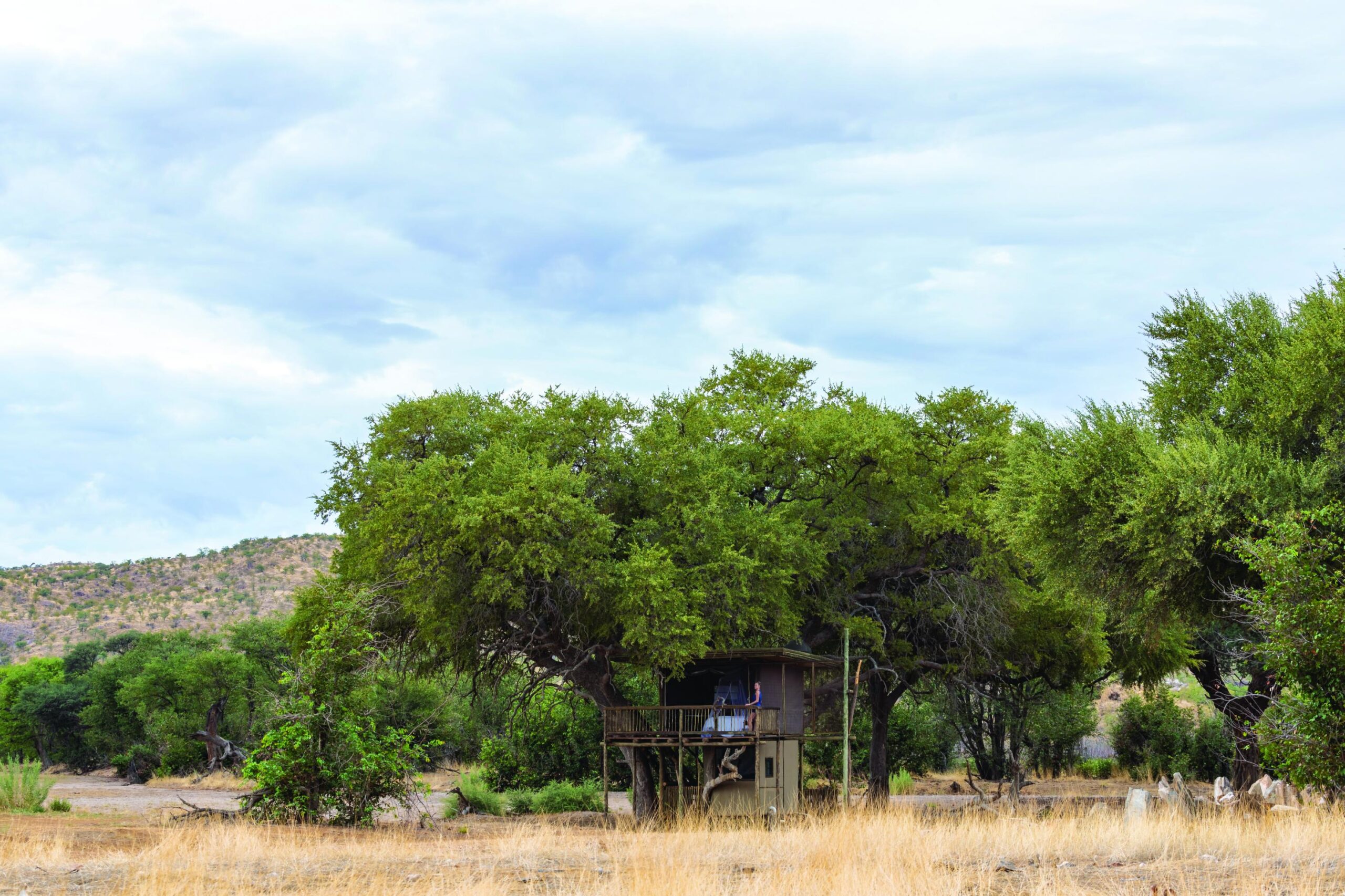

Become one of the pride
at Hobatere Tree House
Welcomed by handshakes and friendly introductions, arriving at Hobatere is like coming home. The journey begins from the moment guests enter the ≠Khoadi-//Hôas conservancy at the main gate, framed by two towers reminiscent of classic stone castles. Barely three kilometres into the conservancy, we spot the first wildlife. Stocky mountain zebras trot across the jeep track, shy to show us their striped pyjamas as they disappear between the mopane forest dotted with honey-coloured boulders.
Text Charene Labuschagne | Photographs Le Roux van Schalkwyk
From the Winter 2023 issue
The road meanders over rocky stretches, soon followed by the thick sand of the Otjovasandu River. And then come the lanky, long- lived trunks of undoubtedly the largest mopane trees I have ever seen. After a long day on the road watching the scenery change from one idiosyncratic landscape to the next, Hobatere feels like an African fairytale painted by the impressionists.
At the reception area await sweet ginger welcoming drinks and refreshing hand towels, as we enter the main landing with a lounge as well as large polished wood bar, dining and outdoor seating areas. One by one, the waiting staff and managers – all community members from nearby villages – greet us with warm smiles. Everyone is made to feel like a guest of honour.
While the game-viewing deck overlooking a nearby waterhole and organic-shaped pool with a trickling water feature both beckon to be enjoyed, our suite for the evening awaits somewhere in the wild. We venture on a game drive with Martin just as a soft rain breaks over the conservancy. A few droplets could not possibly deter us from exploring what Martin calls the termite plains, or the tree house that will be our home for the evening. On the game drive we spot a curious herd of springbok, their coats moistened by the drizzle and juxtaposed by the bronze termite mounds that protrude like pointy hats from the level landscape. Two scavenging jackals dash through the shrubs, their prowess visible in the sunken shoulders, lowered head and stealthy jog to the next leftover feast.
Then come the birds in all their spotted and colourful glory. One of my favourites, the Lilac-breasted Roller, is perched picturesquely on a branch overhanging the road. These brilliant blue and purple feathered avians always seem to flutter off just as you’ve framed the picture through your camera viewfinder, right before you can capture them digitally. Yet it is in flight that this roller is at its most endearing, their technicolour plumage in full display. The Damara Red-billed and Monteiro’s Hornbill, both endemic to northern Namibia and southern Angola, showcase their impressive banana-shaped beaks on treetops. And the Blue- eared Starling’s iridescent feathers catch the light filtering through the rain clouds above.
Our game drive ends ceremoniously with a sundowner gin and tonic and authentically Namibian snacks of biltong and home- made crisps. Parked on a wide open plain surrounded by soft peaks, remnants of the passed rain make for a brilliant sunset, so characteristic of this land. From here we observe the Hobatere tree house, camouflaged under a treeline by its canvas and wood double-storey structure.
Here Martin bids us farewell, driving off in a cloud of dust as we investigate the storybook structure. In the shade of a tree, the Hobatere tree house is enclosed by a shoulder-high wooden fence, an essential barrier between guests and the wild ones that roam around freely. At its base, the tree house features an indoor gas-heated shower, flushing toilet and basin, complete with a window-framed view of the landscape that surrounds it. Up to the second storey, where an expansive wooden deck overlooks the nearby waterhole, a secondary, smaller tree’s trunk protrudes the deck floor. When seated outside on classic canvas camping chairs, these two trees embrace you, solidifying the storybook experience.
As daylight fades, we dive into the three hefty cooler boxes comprising our drinks and dinner selection for the evening. The Hobatere team have simplified the semi self-catering experience, sparing no effort with a table-setting kit including white linen tablecloth, napkins, cutlery and crockery. A crisp bottle of Bordeaux is cracked, and we help ourselves to an aromatic butternut soup starter under the faint, ambient light of safari- inspired lamps.
We have only just begun tucking into a platter selection of salads and crumbed chicken when the soundtrack to the evening commences. As if amplified over a speaker, the deep huff and puff of a male lion fills the silence. Roaring from the loneliest crevice of his soul, the lion’s call sends a spell of chills down our spine. The only thing louder than his call for mates is the audible thumping of our hearts. Without a moment’s hesitation the spotlight is projected into the distance. Surely he cannot be that close… As the floodlight fills a dark night and we survey to spot the calling cat, two red eyes appear merely 150 metres from the deck, and the faint shape of the lion’s reclining position confirms our suspicions – he really is that close!
After dessert, our only other companion at the tree house falls silent; the adrenaline rush simmers to a deep sleep after retiring to the mosquito net canopy bed. A sliding mesh door allows the midnight breeze to cool down the tree house sleeping quarters, with the added peace of mind that creatures are kept at bay. Arising with the soft light of sunrise, the feeling of sheer isolation, of spending the night in a rustic tree house at the mercy of nature, the uncanny closeness to Africa’s most iconic cat and the splendour of great red wine and a wholesome dinner will forever remain etched into memory. Hobatere’s mantra rings true – we have become one of the pride. TNN
Tel: +264 61 228 104
Email: ✉️
www.journeysnamibia.com






